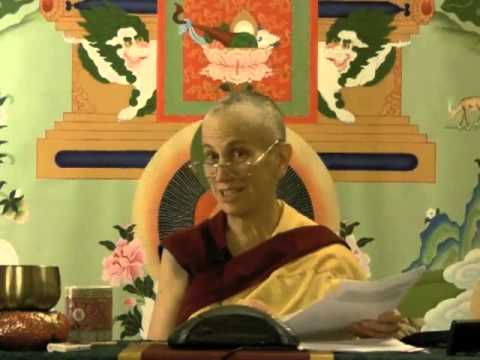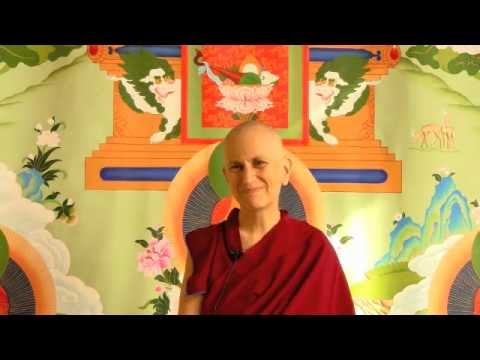Mantras and symbols
This talk was given during the White Tara Winter Retreat at Sravasti Abbey.
- Meaning and purpose of mantras
- Dissolving the visualization
- The symbolism of Tara’s appearance
White Tara Retreat 10: Q&A on mantra, sadhana, and symbolism (download)
Rather than continuing to go through the sadhana today, I’m just going to answer some questions, because they’ve been flowing in.
Purpose, meaning, and ways of saying mantras
Somebody has asked about mantra and what the purpose of mantra is, and should we say it out loud or silently, and how does it connect us to White Tara.
Mantras are sounds or words that were said by highly realized beings who had become, for example, White Tara or any of the other deities, in their deep states of meditation. These are the words that came out expressing their realization. It’s interesting because they were in deep meditation and these words of the mantra came out. We say the words of the mantra trying to go into the same deep state of meditation they had. So, they’re going this way; we’re going that way. The mantras we always say in Sanskrit. We don’t translate them because its said that there’s something sacred about the sounds of the words because those were exactly what was uttered by the deities.
You can say the mantras fast or slow, out loud or silently. You may do it in different ways at different times. For example, when you’re chanting with a group of people then you often do it out loud and you might do it with a certain melody. When you’re accumulating mantra (a certain number of mantra in your meditation), then you usually say the mantras just moving your lips a little bit so that the sound is between your teeth and your lips. In other words, your neighbor should not hear it. Sometimes your mind might get very quiet and you cease to move your lips, and you’re saying it silently inside. It depends on where you’re at in a particular time.
When we’re accumulating mantra we usually say it very quickly; and then we don’t chant it in a melodious way. With the White Tara retreat it’s very good if you can do at least 100,000 of the om tare tuttare ture soha mantra. And then of course, you do 10% [extra] to make up for mistakes. It can be very helpful sometimes to have the number of mantra that you say, because it keeps you going in what you’re doing. Having a number you shouldn’t get stressed out about, “Oh no! How many do I have to do each session in order to get that number?” That’s not helpful. On the other hand if you think, “Oh, I’d like to chant 100,000 of these,” then your mind stays focused and directed on doing that; and you stop getting so distracted and going off here and there and everywhere else.
How do they connect us to the deity? Like I said, we’re trying to go into the same meditative absorption that the deities were in, the awareness—the unity of bodhicitta and wisdom, of compassion and wisdom, of method and wisdom—that they were in. We’re trying to go into their state, when they said these mantras.
It’s helpful to know the translation of the mantra. They usually subsume the whole meaning of the path or some of the qualities of the deity. Sometimes the mantras are just repeating the name of the deity, but then, of course, the names of the deities often have meaning themselves.
You can contemplate the meaning while you’re saying the mantra. But usually when you’re saying the mantra, you want to focus on saying the mantra—on the sound.
How to dissolve Tara at the end of the practice
Somebody was asking, “How do we dissolve Tara at the end of the practice?”
If you’re doing the short sadhana, there isn’t a particular dissolution. But if you take it from other practices, then what happens is Tara on your head would dissolve into light and flow down and merge into your own heart. Then you stay meditating—that your body, speech, and mind and Tara’s body, speech, and mind have become indistinguishable. You especially think of Tara’s realizations and you think, “Oh, well, what would it feel like to have those realizations myself?” So then you feel very close and united with Tara because you imagine having her realizations. That’s a good way to dissolve at the very end of it [the practice] and then do the dedication [prayers] after that.
Tara’s jewels
The other question was on Tara the Liberator: How to Free Your Mind (page 22). It says that her dazzling jeweled necklaces, armlets, anklets, earrings and tiara indicate the six far-reaching practices or the practices of far-reaching generosity, ethical conduct, fortitude, joyous effort, meditative stabilization and wisdom and that these are fully integrated into her being and decorate her every activity. Can I explain these?
The six far-reaching practices I won’t explain right now because you can look those up; nearly every book on the stages of the path has some explanation of them. Or, if you go to my website and look up the six far-reaching attitudes, you’ll find it there. But the idea of her wearing jewelry is that what makes her beautiful are the six far-reaching practices. Tara has inner beauty that gets reflected in the external beauty. Whereas most of us have a mind full of ignorance, anger, and attachment and we try to make our body beautiful to convince other people we’re really great. So this is setting a different example for us on how to be. In other words, let go of caring about decorating this body (which is produced by ignorance and karma) and instead let’s create the six far-reaching practices and those virtues in our mind. If we have those, then the inner beauty shines much greater and with radiance.
Venerable Thubten Chodron
Venerable Chodron emphasizes the practical application of Buddha’s teachings in our daily lives and is especially skilled at explaining them in ways easily understood and practiced by Westerners. She is well known for her warm, humorous, and lucid teachings. She was ordained as a Buddhist nun in 1977 by Kyabje Ling Rinpoche in Dharamsala, India, and in 1986 she received bhikshuni (full) ordination in Taiwan. Read her full bio.


